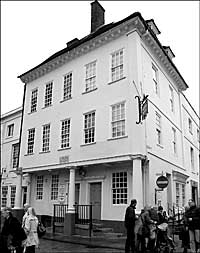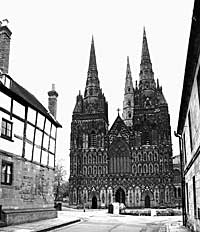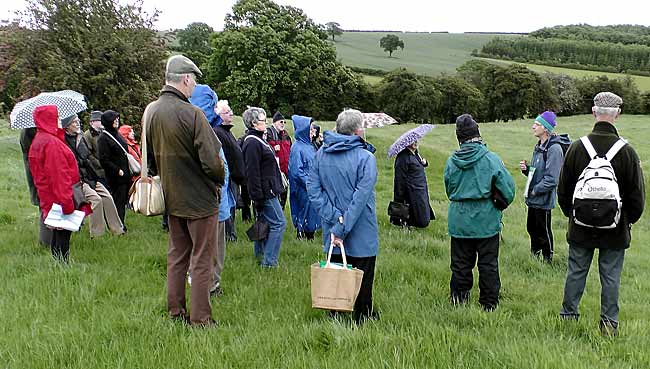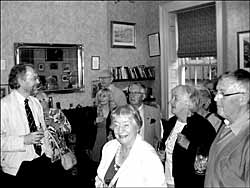Events and excursions, Summer 2012
LICHFIELD – SATURDAY 19 MAY 2012
Leader: Alan Langton

Samuel Johnson Birthplace Museum.

Lichfield Cathedral.
Our visit to this compact and well-pedestrianised town began with a visit to the Samuel Johnson Birthplace Museum, where we enjoyed a guided tour of the five floors of period rooms displaying the famous English Dictionary and personal items belonging to Johnson and his family – together of course with many hundreds of books.
After coffee in the Heritage Centre, we had a guided tour of a most impressive and well laid out exhibition of aspects of the local history of Lichfield. Most stunning was the display of the Staffordshire Millennium Embroideries. The whole centre is tastefully situated in the premises of the very large Saint Mary’s church, combining a place for worship as well as the areas for the restaurant and for the exhibitions.
After free time for lunch we had tours of the cathedral booked, led by three very knowledgeable and entertaining guides. A wedding had just finished as we arrived, and the very cold wind made us pleased not to be standing in flimsy wedding garb outside the west front for photographs!
A Saxon church was first dedicated on this site around 700 AD, and the Norman cathedral was begun in 1085. The whole building demonstrates not only its progression of styles through the centuries, but also the loving care and dedication of the many people responsible for it over the years. It was a pleasure to view the ‘Lichfield Angel’ and the Chad Gospels in the Chapter House, as well as the mechanical platform which can be raised or lowered for services in the nave.
After the tour we enjoyed a good tea in the Chapters’ Restaurant.
Alan Langton
FOUR ARCHAEOLOGICAL SITES – SATURDAY 9 JUNE 2012
Leader: Dr. David Knight

Dr. David Knight explaining features of Oxton Hill Fort to the outing group on 9 June 2012 (Photo: Howard Fisher).
This fascinating trip for members consisted mainly of tramping through long (often wet) grass and having a vivid imagination about what might once have existed beneath our feet.
The first stop was at Oxton to see the site of an Iron Age fort at the top of a local hill. After quite a long walk, the views were splendid, and with the detailed explanation given to us by David, the plan of the fort in the hollow of the fields became recognizable. One or two sturdy members actually walked higher up the hill to enjoy the views.
From Oxton we journeyed to Norwell, mentioned in Domesday, and more specifically, to the site of Willoughby deserted village, where Michael Jones, a local historian, gave us a very detailed talk about what might have stood on this large English Heritage protected area. Of particular interest is the place where a manor house might well have been, together with obvious evidence of fish ponds and moats.
Our lunch stop was at Devon Park, Newark, where the remains the four corners of the Queen’s Sconce now stand. This was the Royalists’ stronghold during the Civil War, and it is one of the best surviving examples of 17th century military engineering in the country.
Our last stop was at Bingham where Adrian Henstock was able to give us first hand details of recent surveys done in Crow Close, the site of a medieval, or just post-medieval, village. Members were most interested again to try and imagine what might have stood in various parts of the field, and so too was a herd of cows who found it difficult to drag themselves away from Adrian’s and David’s talks. One of Adrian’s local history colleagues proved to be an excellent cowman, shooing them away when they became too closely curious.
Tea was served to us in the Horse and Plough public house – once a Primitive Methodist chapel!
All in all, quite a tiring day, but one which David had planned with significant detail.
Alan Langton
WINE TASTING AND SOCIAL EVENING – 17 CASTLE GATE, NOTTINGHAM; 19 JULY 2012

Members on the evening (Photo: David Hoskins).
On a wet and warm(ish) July evening, a group of Thoroton members knocked at the discrete green door and were admitted to one of Nottingham’s secret gems. 17 Castle Gate is a Georgian town house dating from the early 18th century, now owned and restored by Weavers of Nottingham Ltd. and used by them for storing some of their stock of wine.
By special arrangement, Thoroton members were privileged to be shown parts of the building not normally seen by the public including upper rooms and deep cellars carved out of the natural sandstone below. All this whilst sampling some excellent wines, specially selected by Philip Trease and Mike Stacey and served in the principal rooms as we went around.
In his introduction, Philip told us that the Trease family had been running the business since 1897 when his great-great-grandfather, George Trease, bought the then Weavers Vaults public house in Lister Gate. Philip then added that our evening was one of historical significance to the company as he introduced his niece, Rachel, as the sixth generation of the Trease family to be involved in the business and who was assisting with a wine-tasting for the first time.
In 1989 Weavers acquired the freehold of 17 Castle Gate, having previously only rented the cellars for wine storage, and embarked on a programme of restoring the principal rooms. We were invited to inspect the results of the restoration from the elegant entrance hall, with its original staircase, through to four reception rooms on the ground and first floors. We were introduced to such gems as pressed plaster as a wall decoration, original cornices and ‘economy corners’ where dado paneling was much less decorative where it was not in full view and there was less need to impress! One of the rooms was dedicated to memorabilia of the wider Trease family, including Philip’s great-uncle Geoffrey, the children’s author.
Throughout the visit, our own Pete Smith, following on from his presentation More Nottingham Townhouses in February, was able to add an additional perspective to the commentary on what we were seeing. The more adventurous members were then able to climb the upper staircase to the unrestored second floor, with its decorative clues as to the status of the various people who had used the rooms there. The evening concluded with a visit to the upper cellars, still stocked with wine, where discussion centred on their possible original use as kitchens, and then the deep cellars carved out of the natural sandstone that underpinned the whole house.
Our grateful thanks go to Pete Smith for his additional descriptions of the building, to the team from Weavers, Philip Trease, Mike Stacey and Rachel Trease, for their knowledge and assistance during the evening, and to Alan Trease for making the whole visit possible.
David Hoskins